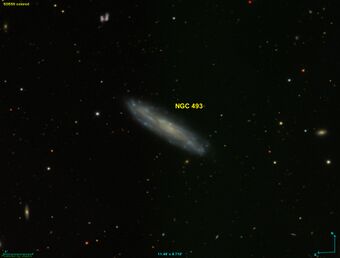Astronomy:NGC 493
From HandWiki
Short description: Galaxy in the constellation Cetus
| NGC 493 | |
|---|---|
 SDSS view of NGC 493 | |
| Observation data (J2000 epoch) | |
| Constellation | Cetus |
| Right ascension | 01h 22m 09.54s |
| Declination | +00° 56′ 47.5″ |
| Redshift | 0.007799 ± 0.000017 |
| Helio radial velocity | (+2329 ± 5) km/s |
| Distance | 90 Mly |
| Apparent magnitude (V) | 12.2 |
| Characteristics | |
| Type | SAB(s)cd? |
| Apparent size (V) | 4.3′ × 1.7′ |
| Other designations | |
| PGC 4979, GC 281, UGC 914, 2MASS J01220898+0056432, Z 385.84, MGC +00-04-099, IRAS 01195+0041, H 3.594, h 105 | |
NGC 493, also occasionally referred to as PGC 4979 or GC 281, is a barred spiral galaxy in the constellation Cetus.[1] It is located approximately 90 million light-years from Earth and was discovered on December 20, 1786 by astronomer William Herschel.[2] It was later also observed by his son, John Herschel. John Dreyer, creator of the New General Catalogue, described the galaxy as "very faint, large, much extended 60°" with "a little brighter middle".[3]
Two supernovae have been observed in NGC 493: SN 1971S (mag. 15.5)[4] and SN 2016hgm (type II, mag. 17.9).[5]
See also
References
- ↑ "Revised NGC Data for NGC 493". http://spider.seds.org/ngc/revngcic.cgi?NGC493.
- ↑ "Your NED Search Results". http://ned.ipac.caltech.edu/cgi-bin/nph-objsearch?objname=NGC+493.
- ↑ "astronomy-mall.com/Adventures.In.Deep.Space/NGC%201-7840%20complete.htm". http://www.astronomy-mall.com/Adventures.In.Deep.Space/NGC%201-7840%20complete.htm.
- ↑ Transient Name Server entry for SN 1971S. Retrieved 25 March 2023.
- ↑ Transient Name Server entry for SN 2016hgm. Retrieved 25 March 2023.
External links
- NGC 493 on WikiSky: DSS2, SDSS, GALEX, IRAS, Hydrogen α, X-Ray, Astrophoto, Sky Map, Articles and images
- SEDS
 |

